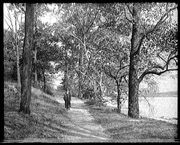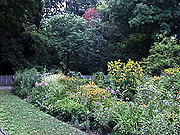Bartram’s Garden
 |
| One of Philadelphia's most beautiful places during Meriwether Lewis' visit to Philadelphia was Bartram's Garden. Image courtesy Library of Congress, Prints and Photographs Division, Detroit Publishing Company Collection. |
| |
 |
| The garden that John Bartram started almost three centuries ago still flourishes today. |
One of Philadelphia's most beautiful places during Meriwether Lewis' visit to Philadelphia was Bartram's Garden, which still exists today.
The garden was started in 1728 by John Bartram, America's first great botanist, naturalist, and plant explorer. The self-taught Bartram bought a 102-acre farm on the western outskirts of Philadelphia. Bartram traveled north to Lake Ontario, south to Florida, and west to the Ohio River in search of plants and natural history specimens for his botanic garden and for collectors at home and in Europe. Bartram and his son, William, are credited with identifying and cultivating more than 200 plants native to America. The elder Bartram's international reputation earned him the honor of royal botanist from King George III in 1765, a position he held until his death in 1777.
William was the fifth of John Bartram's nine children. He was formally educated but failed at several businesses and farming. In 1773 he began a four-year journey through eight southern colonies. He made numerous drawings and took detailed notes on the flora, fauna, and Native Americans he encountered. He published his journals in 1791, and they remain today an American natural history classic.
By the time of Lewis' visit to Philadelphia, Bartram's Garden was a flourishing nursery. The Bartram family had issued the first printed plant catalog in America and had supplied plants for Independence Hall, Mount Vernon, and Monticello. The Bartrams eventually propagated more than 4,000 species of native and exotic plants.
In 1850 industrialist Andrew Eastwick, who had roamed Bartram's Garden as a child, purchased the land to save it from the industrial sprawl overtaking the lower Schuylkill River. In 1891 Eastwick's former gardener, Thomas Meehan, then a city councilman, led the campaign that added Bartram's Garden to the city's public park system. It remains open to the public today.
< previous | next > |



